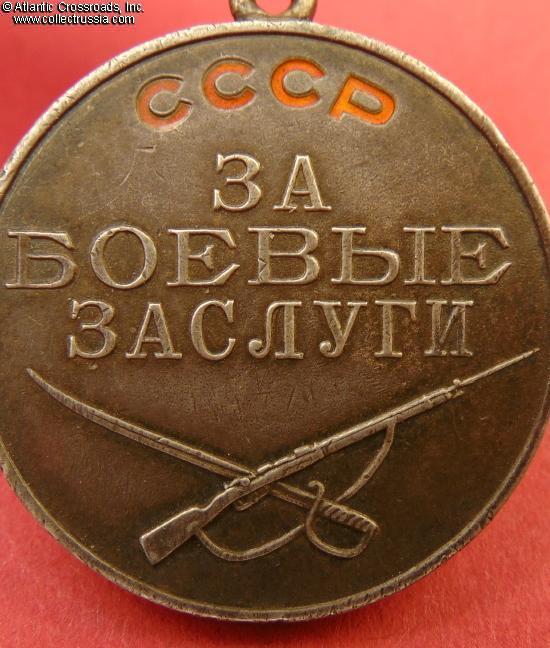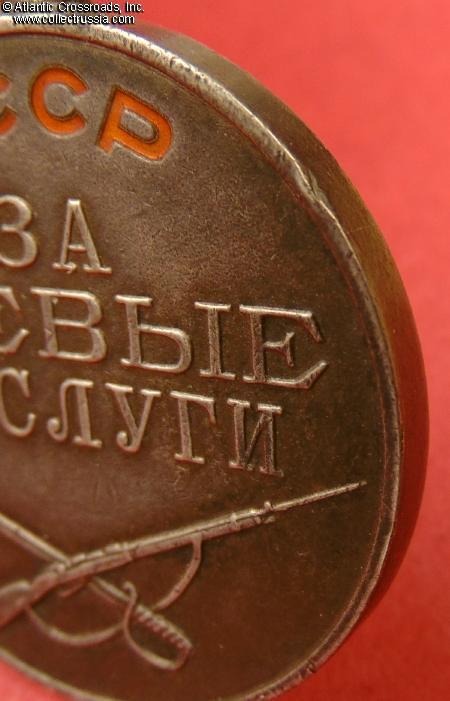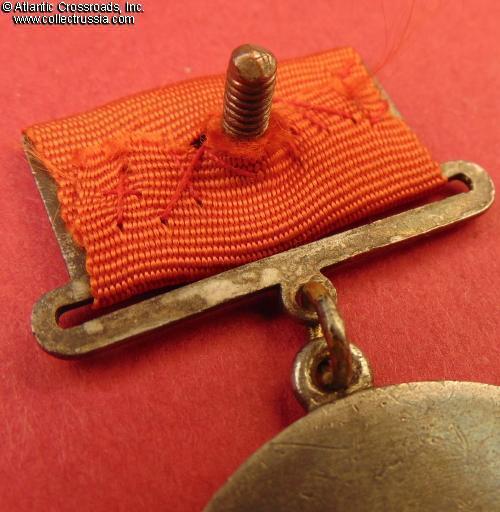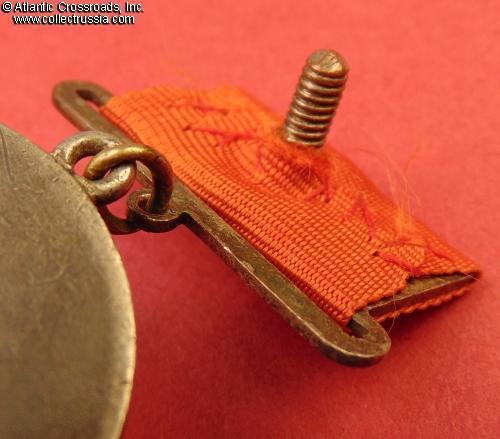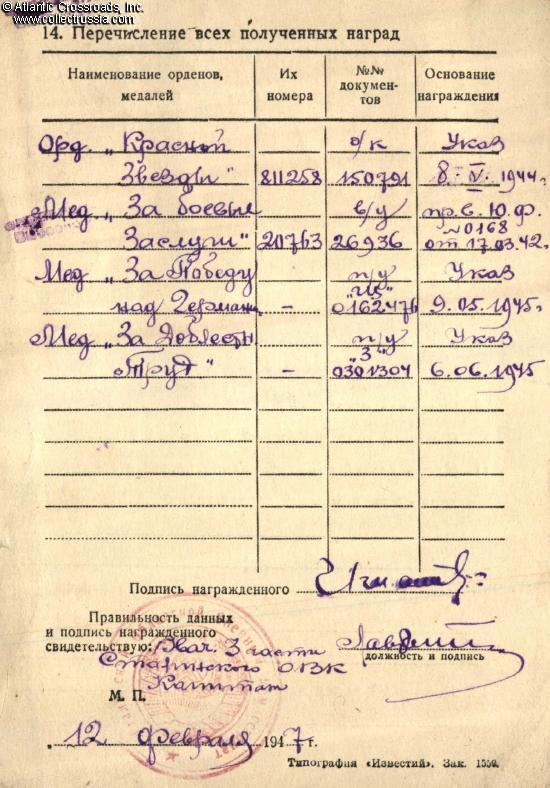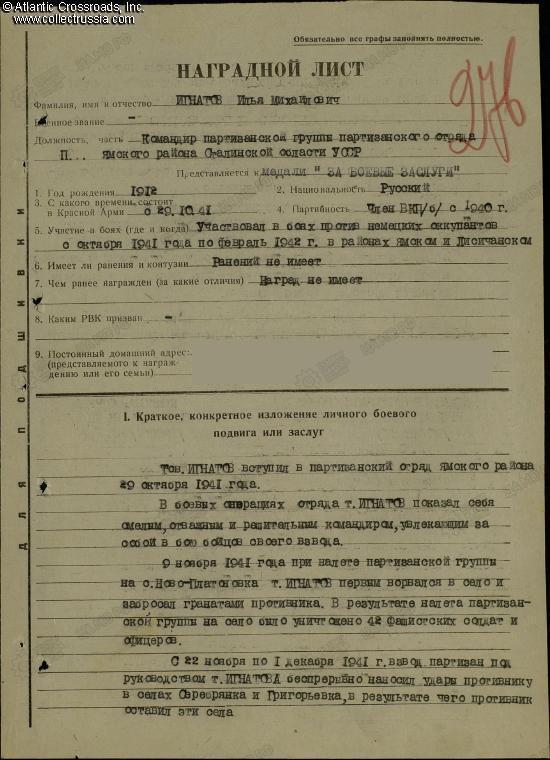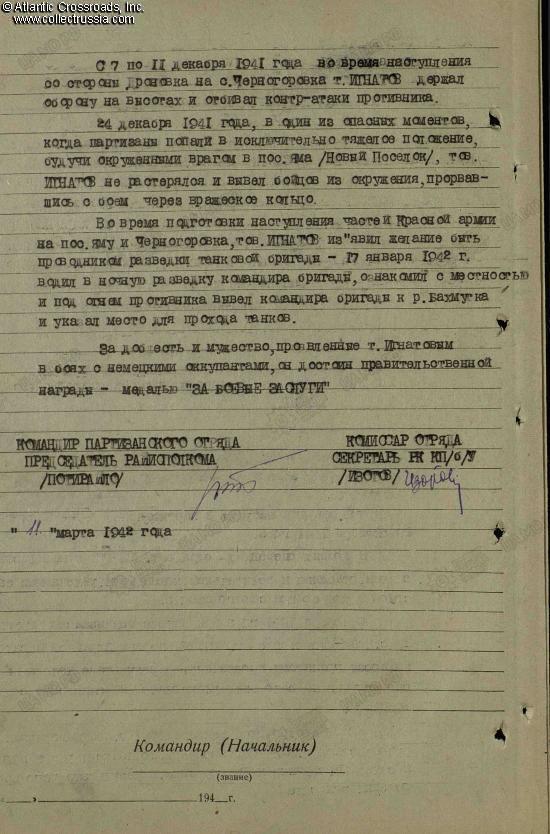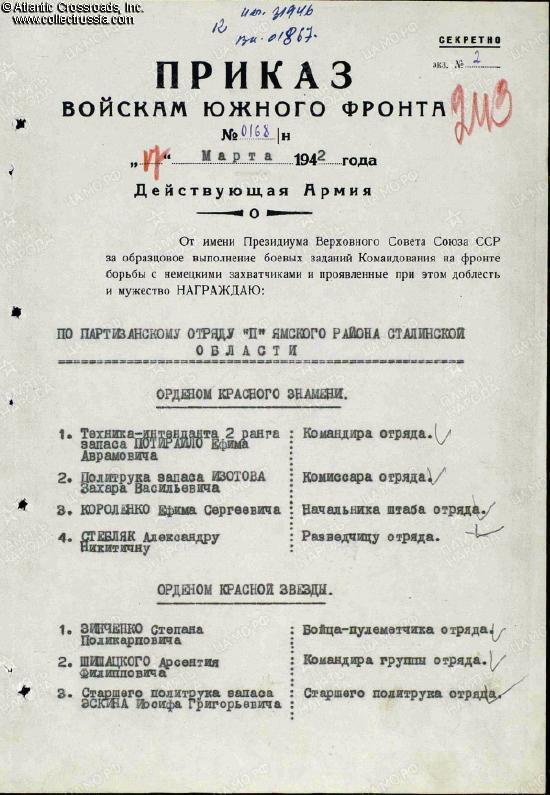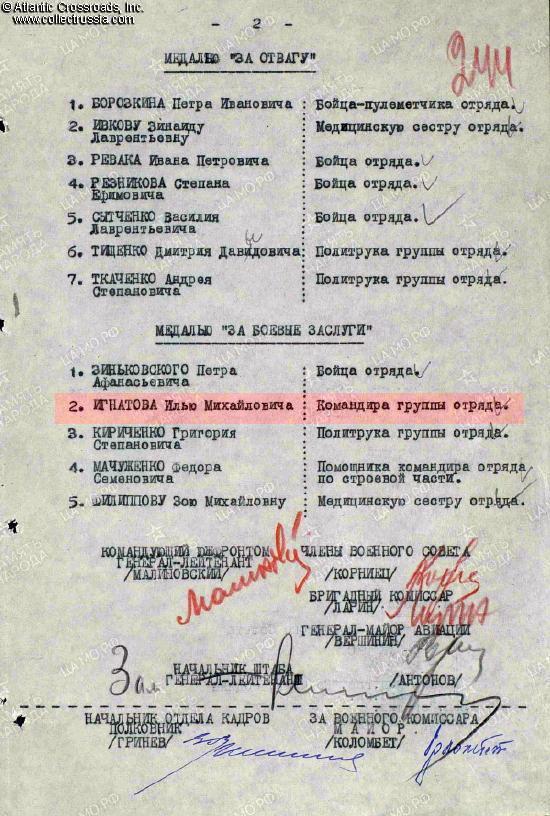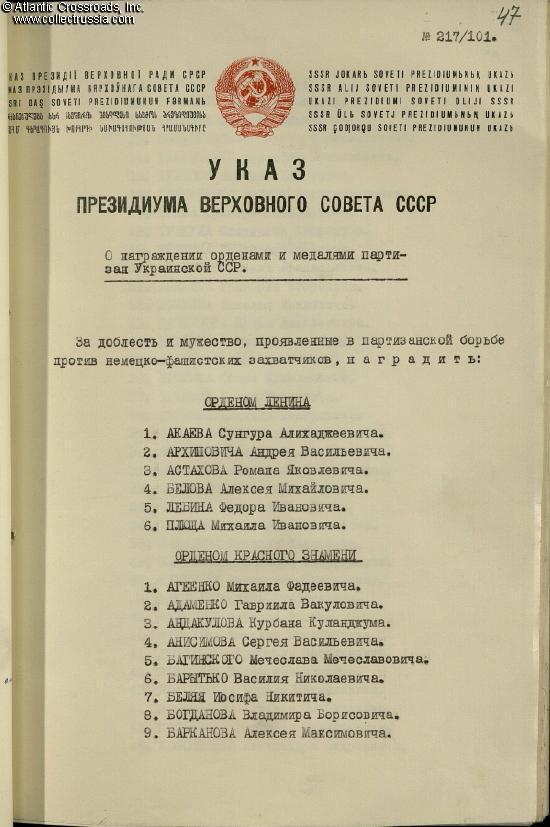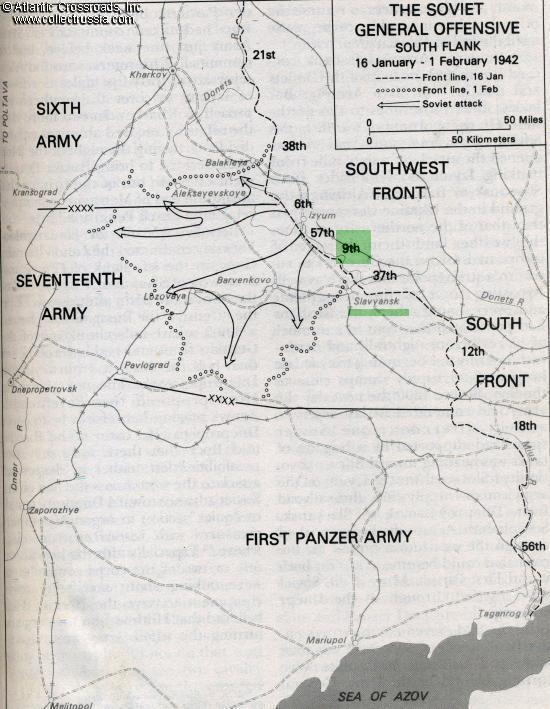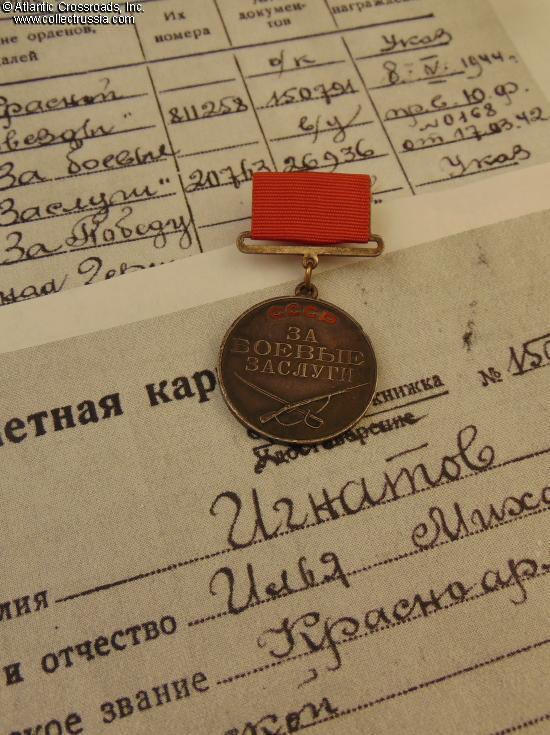
Medal for Combat Service, Type 1, Variation 1, #20763, awarded on 17 March 1942 to Private Ilya Ignatov, Partisan Platoon Commander, for conducting bold strikes in the enemy rear in November - December 1941 and providing substantial support to the regular Red Army units during the Soviet general offensive in January 1942.
The medallion is in silver and enamel; 32.2 mm wide, weigh 22.2 grams not including the suspension and connecting link. Features engraved serial number and smaller suspension with thin copper screw post. The suspension is characteristically small measuring 31.1 mm in width, 17.1 mm in height (not including the provision for the connecting link at the bottom.)
The medal is in very fine to excellent overall condition, very uncommon for the earliest version of this medal and in general for any Soviet decoration awarded in the first year of the Great Patriotic War.
The medallion is in silver and enamel; 32.2 mm wide, weigh 22.2 grams not including the suspension and connecting link. Features engraved serial number and smaller suspension with thin copper screw post. The suspension is characteristically small measuring 31.1 mm in width, 17.1 mm in height (not including the provision for the connecting link at the bottom.)
The medal is in very fine to excellent overall condition, very uncommon for the earliest version of this medal and in general for any Soviet decoration awarded in the first year of the Great Patriotic War. The medallion is extremely well preserved. The enamel in the letters is perfect. The field of the medallion on both sides has only minuscule contact marks and dings, shows beautiful even patina, and appears nearly pristine to the naked eye. The raised details of the rifle and sword are practically perfect and exceptionally crisp. There are only some minor dings to the raised edge, no bumps or significant knocks.
Comes on original suspension device in silver-plated brass complete with characteristically thin copper screw post measuring about 3.3 mm in diameter and original 18.1 mm wide screw plate marked "MONDVOR". The ribbon is clearly old, possibly of WW2 period. As is usually the case with the first version of the Combat Service Medal, the rectangular retaining back plate is missing, and the ribbon has been instead secured in place by the conventional method of sewing together its ends. This is really the only serious flaw of this otherwise excellent example. The connecting link in silver-plated brass appears to be original and its ends are still joined with solder.
Ilya Ignatov was born in 1912 in the town of Slavyansk of the Stalino (now Donetsk) Region. During 1934-36, he served his first stint in the Red Army and in 1940, joined the Communist Party. In October 1941 he was drafted again and judging by the following developments, almost immediately became one of the thousands of Red Army soldiers whose units disintegrated during the German offensives in the fall of 1941. Like many other such servicemen, Ignatov refused to surrender and continued armed struggle in the enemy rear forming the nucleus of the nascent partisan movement.
On 29 October 1941, Ignatov joined one of the early partisan units in the Yamа District in the northeastern part of the Stalino Region, in close proximity of his native town of Slavyansk (the town of Yama has since been renamed Seversk, or Siversk in Ukrainian). Probably due to a combination of factors such as his prior military training, party membership, and familiarity with the area, he was appointed a platoon commander. He soon proved himself as a courageous and capable leader who
inspired other guerrilla fighters by his personal example. On 9 November 1941, Ignatov led a partisan raid on the enemy garrison in the village of Novoplatonovka just north of Slavyansk. He was the first to enter the village lobbing hand-grenades at the enemy. The bold strike killed a total of 42 Nazi soldiers. From 22 November - 1 December, Ignatov's platoon relentlessly attacked the enemy in the villages of Serebryanka and Grigoryevka in the same area forcing them to abandon both locations.
In the period from 7-11 December, at the start of the Soviet winter counteroffensive, Ignatov with his platoon occupied high ground near the village of Chernogorovka about half-way between Stalino (Donetsk) and Voroshilovgrad (Luhansk.) The platoon held its position despite several German counterattacks. On 24 December, the partisans found themselves in exceptionally hard situation when they were surrounded by the enemy near the town of Yama. Not losing presence of mind, Ignatov found a way out and led his detachment from the enemy trap.
As the Red Army prepared for the next phase of its offensive in January 1942, Ignatov volunteered to be a guide for a Soviet tank brigade planning to attack Yama and Chernogorovka. On 17 January, he jointly with the commander of the brigade conducted a thorough nighttime reconnaissance of the enemy positions and when they were discovered by the enemy and came under fire, led the commander to safety. He also pointed out a location where the terrain allowed the tanks to ford the Bakhmutka River.
On 11 March 1942, Ignatov was recommended for the Medal for Combat Service by his partisan unit commander and commissar. The medal was bestowed on him six days later by a special decree of the Southern Front which awarded various decorations to 19 partisans of the Yama (Yamskiy) Partisan Unit - a testimony to the unit's effectiveness in providing support to the regular troops of the front. At that point, Ignatov had re-joined the regular Red Army as private of the 897th Rifle Regiment, 242nd Rifle Division, 9th Army, Southern Front. He remained on active duty in the military through September 1943. Although nothing else is known about his combat service after March 1942, he was probably wounded or otherwise found unfit for further military duty in 1943. He did survive the war and judging by the fact that he received both the Medal for Victory over Germany and Medal for Meritorious Labor during the Great Patriotic War in 1945, worked for the home front in the last two years of the war. Interestingly, in May 1943 Ignatov was also belatedly awarded with an Order of the Red Star - his only other combat decoration of the war - by the USSR Supreme Soviet in recognition of his past actions as a partisan.
Research Materials: photocopy of the award record card,
award commendation and award decree for the Medal for Combat
Service, and of the relevant pages of the award decree for
the Order of the Red Star.
$950.00 Add to cart

